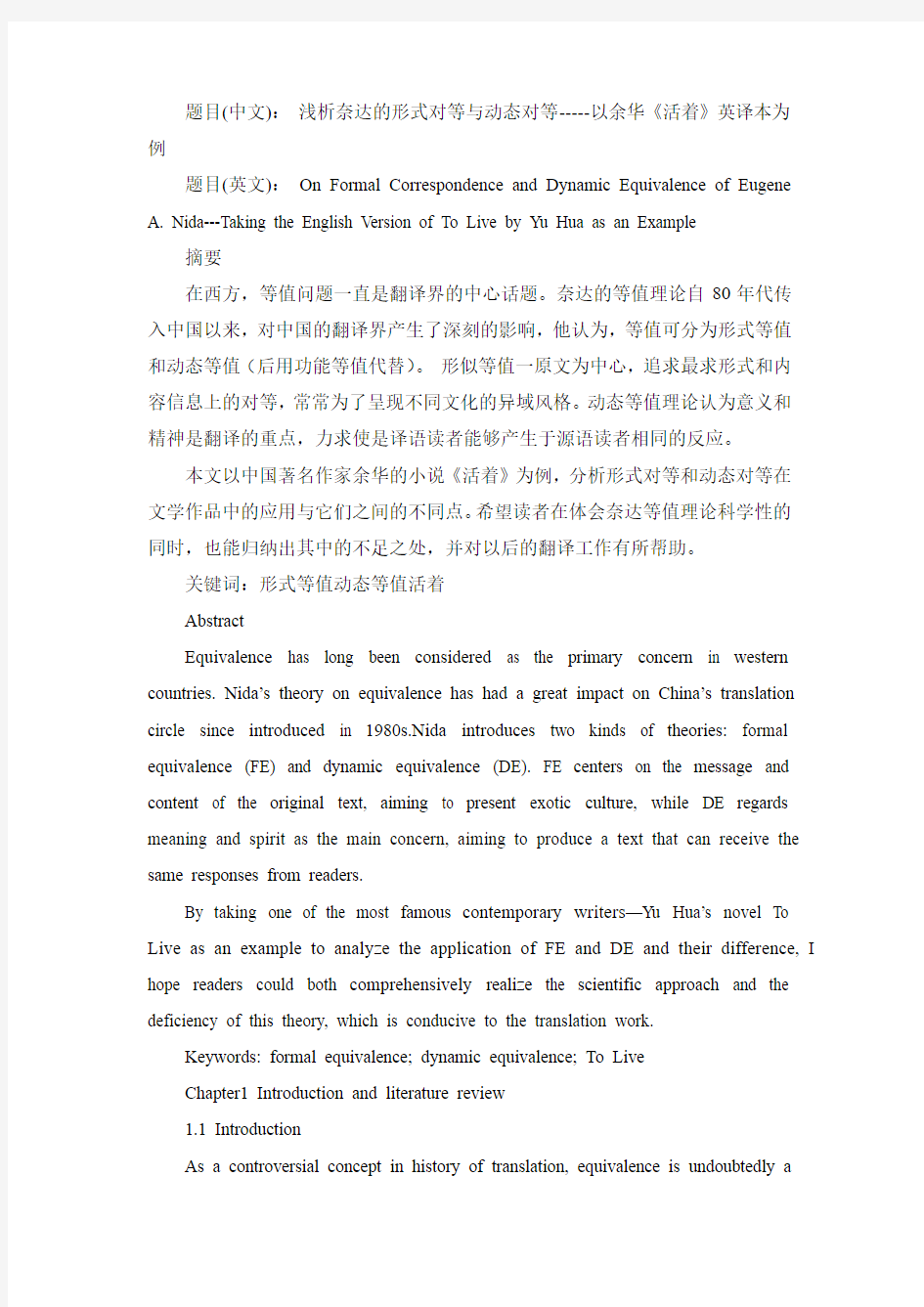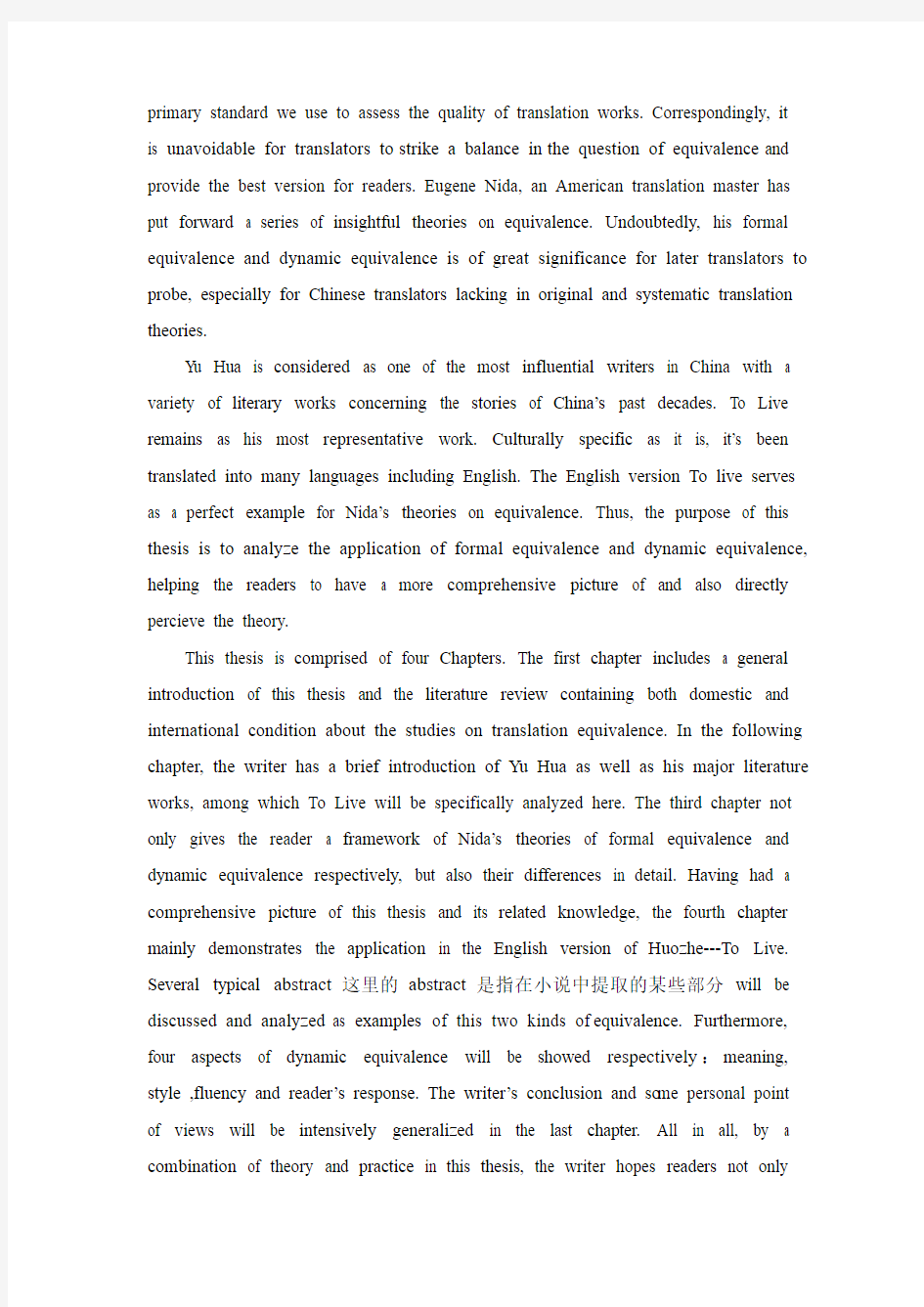浅析奈达的形式对等与动态对等-----以余华《活着》英译本为例


题目(中文):浅析奈达的形式对等与动态对等-----以余华《活着》英译本为例
题目(英文):On Formal Correspondence and Dynamic Equivalence of Eugene A. Nida---Taking the English Version of To Live by Yu Hua as an Example
摘要
在西方,等值问题一直是翻译界的中心话题。奈达的等值理论自80年代传入中国以来,对中国的翻译界产生了深刻的影响,他认为,等值可分为形式等值和动态等值(后用功能等值代替)。形似等值一原文为中心,追求最求形式和内容信息上的对等,常常为了呈现不同文化的异域风格。动态等值理论认为意义和精神是翻译的重点,力求使是译语读者能够产生于源语读者相同的反应。
本文以中国著名作家余华的小说《活着》为例,分析形式对等和动态对等在文学作品中的应用与它们之间的不同点。希望读者在体会奈达等值理论科学性的同时,也能归纳出其中的不足之处,并对以后的翻译工作有所帮助。
关键词:形式等值动态等值活着
Abstract
Equivalence has long been considered as the primary concern in western countries. Nida’s theory on equivalence has had a great impact on China’s translation circle since introduced in 1980s.Nida introduces two kinds of theories: formal equivalence (FE) and dynamic equivalence (DE). FE centers on the message and content of the original text, aiming to present exotic culture, while DE regards meaning and spirit as the main concern, aiming to produce a text that can receive the same responses from readers.
By taking one of the most famous contemporary writers—Yu Hua’s novel To Live as an example to analyze the application of FE and DE and their difference, I hope readers could both comprehensively realize the scientific approach and the deficiency of this theory, which is conducive to the translation work.
Keywords: formal equivalence; dynamic equivalence; To Live
Chapter1 Introduction and literature review
1.1 Introduction
As a controversial concept in history of translation, equivalence is undoubtedly a
primary standard we use to assess the quality of translation works. Correspondingly, it is unavoidable for translators to strike a balance in the question of equivalence and provide the best version for readers. Eugene Nida, an American translation master has put forward a series of insightful theories on equivalence. Undoubtedly, his formal equivalence and dynamic equivalence is of great significance for later translators to probe, especially for Chinese translators lacking in original and systematic translation theories.
Yu Hua is considered as one of the most influential writers in China with a variety of literary works concerning the stories of China’s past decades. To Live remains as his most representative work. Culturally specific as it is, it’s been translated into many languages including English. The English version To live serves as a perfect example for Nida’s theories on equivalence. Thus, the purpose of this thesis is to analyze the application of formal equivalence and dynamic equivalence, helping the readers to have a more comprehensive picture of and also directly percieve the theory.
This thesis is comprised of four Chapters. The first chapter includes a general introduction of this thesis and the literature review containing both domestic and international condition about the studies on translation equivalence. In the following chapter, the writer has a brief introduction of Yu Hua as well as his major literature works, among which To Live will be specifically analyzed here. The third chapter not only gives the reader a framework of Nida’s theories of formal equivalence and dynamic equivalence respectively, but also their differences in detail. Having had a comprehensive picture of this thesis and its related knowledge, the fourth chapter mainly demonstrates the application in the English version of Huozhe---To Live. Several typical abstract这里的abstract是指在小说中提取的某些部分will be discussed and analyzed as examples of this two kinds of equivalence. Furthermore, four aspects of dynamic equivalence will be showed respectively:meaning, style ,fluency and reader’s response. The writer’s conclusion and so me personal point of views will be intensively generalized in the last chapter. All in all, by a combination of theory and practice in this thesis, the writer hopes readers not only
